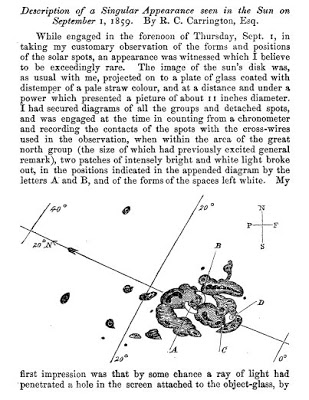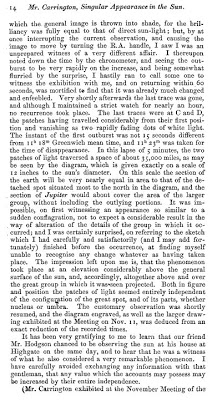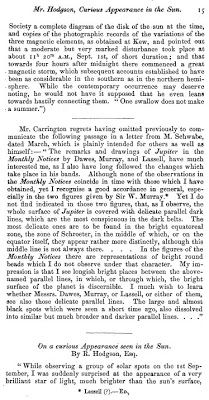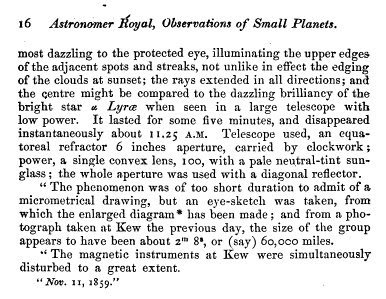Philosophy
A familiar story of witnessing something and having the event diminish or vanish when a corroborating witness is summoned...like calling the police complaining about a noisy neighbor and all is quiet when they finally arrive.
Thursday, September 1st, 1859, 11:18am:
Thirty three year-old Richard Carringto, widely acknowledged to be one of England's foremost solar astronomer, was in his well-appointed private observatory. Just as usual on every sunny day, his telescope was projecting an 11-inch-wide image of the sun on a screen, and Carrington skillfully drew the sunspots he saw.
On that morning, he was capturing the likeness of an enormous group of sunspots. Suddenly, before his eyes, two brilliant beads of blinding white light appeared over the sunspots, intensified rapidly, and became kidney-shaped. Realizing that he was witnessing something unprecedented and "being somewhat flurried by the surprise," Carrington later wrote, "I hastily ran to call someone to witness the exhibition with me. On returning within 60 seconds, I was mortified to find that it was already much changed and enfeebled." He and his witness watched the white spots contract to mere pinpoints and disappear.
Friday, September 2nd, 1859:
Just before dawn the next day, skies all over planet Earth erupted in red, green, and purple auroras so brilliant that newspapers could be read as easily as in daylight. Indeed, stunning auroras pulsated even at near tropical latitudes over Cuba, the Bahamas, Jamaica, El Salvador, and Hawaii. Even more disconcerting, telegraph systems worldwide went haywire. Spark discharges shocked telegraph operators and set the telegraph paper on fire. Even when telegraphers disconnected the batteries powering the lines, aurora-induced electric currents in the wires still allowed messages to be transmitted.
[Click the following images for better reading.]




Forecasting the Impact of an 1859-calibre Superstorm on Satellite Resources
THE 1859 SOLAR–TERRESTRIAL DISTURBANCE AND THE CURRENT LIMITS OF EXTREME SPACE WEATHER ACTIVITY
Book:
May be read online.
Space Radiation Hazards and the Vision for Space Exploration: Report of a Workshop
- Astronomy Chromolithograph Images From The Victorian Era
A chromolithograph of the planet Jupiter, observed Nov. 1, 1880, at 9:30 p.m. The piece of art reveals Jupiter's Great Red Spot, akin to a hurricane on Earth, which has been raging on the planet for hundreds of years. "Amazing Astronomy Illustrations...
- Worse Than A Nuclear Winter?
"Is a Devastating Solar Flare Coming to a City Near You?" by Ian O'Neill June 16th, 2010 Discovery News As NASA warns of a massive surge of solar energy potentially impacting our way of life, the mainstream press reacts, finally. However, these...
- Deceased--john A. Eddy
John A. Eddy March 25th, 1931 to June 10th, 2009 "John A. Eddy, Solar Detective, Dies at 78" by Bruce Weber June 18th, 2009 The New York Times John A. Eddy, a solar astronomer who studied the history of the sun and demonstrated that it is not a constant...
- Doom And Gloom Scenario--for Real
Scenarios like this frequently appear in the press and even literature. It has even taken the mantra of a "nuclear Winter" during the Cold War era. And most of it is true. It is a terrible vision of the future involving the capriciousness of the sun's...
- Nasa's Polar Satellite--"the Broken Heart"/death
NASA's Polar satellite had out lived its parameters of life by a decade and provided volumes of data. Again, a few dollars spent and a wealth of information taken. It is somewhat sad to see the last photograph taken... As far as endings go, this one’s...
Philosophy
Richard Carringto and the 1859 super solar flare
A familiar story of witnessing something and having the event diminish or vanish when a corroborating witness is summoned...like calling the police complaining about a noisy neighbor and all is quiet when they finally arrive.
Thursday, September 1st, 1859, 11:18am:
Thirty three year-old Richard Carringto, widely acknowledged to be one of England's foremost solar astronomer, was in his well-appointed private observatory. Just as usual on every sunny day, his telescope was projecting an 11-inch-wide image of the sun on a screen, and Carrington skillfully drew the sunspots he saw.
On that morning, he was capturing the likeness of an enormous group of sunspots. Suddenly, before his eyes, two brilliant beads of blinding white light appeared over the sunspots, intensified rapidly, and became kidney-shaped. Realizing that he was witnessing something unprecedented and "being somewhat flurried by the surprise," Carrington later wrote, "I hastily ran to call someone to witness the exhibition with me. On returning within 60 seconds, I was mortified to find that it was already much changed and enfeebled." He and his witness watched the white spots contract to mere pinpoints and disappear.
Friday, September 2nd, 1859:
Just before dawn the next day, skies all over planet Earth erupted in red, green, and purple auroras so brilliant that newspapers could be read as easily as in daylight. Indeed, stunning auroras pulsated even at near tropical latitudes over Cuba, the Bahamas, Jamaica, El Salvador, and Hawaii. Even more disconcerting, telegraph systems worldwide went haywire. Spark discharges shocked telegraph operators and set the telegraph paper on fire. Even when telegraphers disconnected the batteries powering the lines, aurora-induced electric currents in the wires still allowed messages to be transmitted.
[Click the following images for better reading.]
Monthly Notices of the Royal Astronomical Society




Forecasting the Impact of an 1859-calibre Superstorm on Satellite Resources
THE 1859 SOLAR–TERRESTRIAL DISTURBANCE AND THE CURRENT LIMITS OF EXTREME SPACE WEATHER ACTIVITY
Book:
May be read online.
Space Radiation Hazards and the Vision for Space Exploration: Report of a Workshop
- Astronomy Chromolithograph Images From The Victorian Era
A chromolithograph of the planet Jupiter, observed Nov. 1, 1880, at 9:30 p.m. The piece of art reveals Jupiter's Great Red Spot, akin to a hurricane on Earth, which has been raging on the planet for hundreds of years. "Amazing Astronomy Illustrations...
- Worse Than A Nuclear Winter?
"Is a Devastating Solar Flare Coming to a City Near You?" by Ian O'Neill June 16th, 2010 Discovery News As NASA warns of a massive surge of solar energy potentially impacting our way of life, the mainstream press reacts, finally. However, these...
- Deceased--john A. Eddy
John A. Eddy March 25th, 1931 to June 10th, 2009 "John A. Eddy, Solar Detective, Dies at 78" by Bruce Weber June 18th, 2009 The New York Times John A. Eddy, a solar astronomer who studied the history of the sun and demonstrated that it is not a constant...
- Doom And Gloom Scenario--for Real
Scenarios like this frequently appear in the press and even literature. It has even taken the mantra of a "nuclear Winter" during the Cold War era. And most of it is true. It is a terrible vision of the future involving the capriciousness of the sun's...
- Nasa's Polar Satellite--"the Broken Heart"/death
NASA's Polar satellite had out lived its parameters of life by a decade and provided volumes of data. Again, a few dollars spent and a wealth of information taken. It is somewhat sad to see the last photograph taken... As far as endings go, this one’s...
